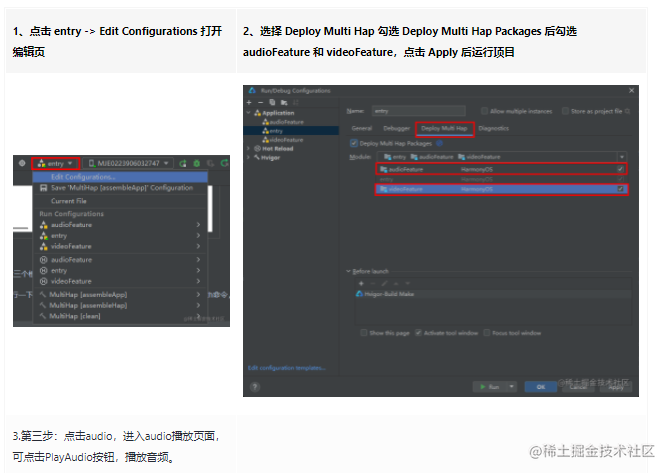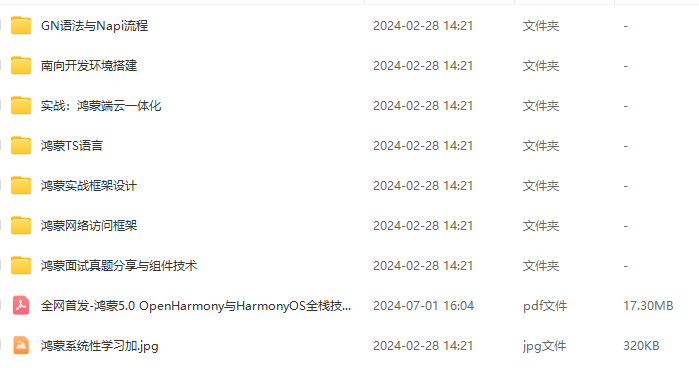多HAP
介绍
本示例展示多HAP开发,简单介绍了多HAP的使用场景,应用包含了一个entry HAP和两个feature HAP,两个feature HAP分别提供了音频和视频播放组件,entry中使用了音频和视频播放组件。 三个模块需要安装三个hap包,最终会在设备上安装一个主entry的hap包。
本示例用到了应用上下文Context接口 @ohos.app.ability.common媒体服务接口@ohos.multimedia.media
效果预览

使用说明:
1.第一步:点击Build->Build Hap(s)/APP(s)->Build Hap(s),构建三个模块的hap包。
2.第二步:使用IDE安装多Hap包。

4.第四步:点击video,进入video播放页面,可点击播放按钮播放视频。
工程目录
├──audioFeature/src/main/ets/ │ ├──application │ │ └──MyAbilityStage.ets │ ├──audioAbility │ │ └──AudioAbility.ets │ ├──pages │ │ └──index.ets // audio组件的实现页面 │ └──util │ └──Logger.ts // 日志工具 ├──audioFeature/src/main/module.json5 // audio模块配置hap类型:"type": "feature" │ ├──entry/src/main/ets/ │ ├──application │ │ └──MyAbilityStage.ets │ ├──mainability │ │ └──MainAbility.ets │ ├──pages │ │ └──index.ets // entry主应用入口,内含首页组件以及发起hap跳转逻辑 │ └──util │ └──Logger.ts // 日志工具 ├──entry/src/main/module.json5 // entry模块配置hap类型:"type": "entry" │ ├──videoFeature/src/main/ets/ │ ├──application │ │ └──MyAbilityStage.ets │ ├──videoability │ │ └──VideoAbility.ets │ ├──pages │ │ └──index.ets // video组件的实现页面 │ └──util │ └──Logger.ts // 日志工具 └──videoFeature/src/main/module.json5 // video模块配置hap类型:"type": "feature" 相关概念
entry:应用的主模块,一个应用中,只有一个entry类型的HAP,一般实现应用的入口界面、入口图标、主特性功能等
feature:应用的特性模块,一个应用中可以包含一个或者多个feature类型的HAP,也可以不含
多HAP:一个应用工程中存在一个entry HAP和多个feature HAP
具体实现
- 新创建两个Module作为将被跳转的hap,分别命名为videoFeature,audioFeature。源码参考[Index.ets]
/* * Copyright (c) 2022-2023 Huawei Device Co., Ltd. * Licensed under the Apache License, Version 2.0 (the "License") * you may not use this file except in compliance with the License. * You may obtain a copy of the License at * * http://www.apache.org/licenses/LICENSE-2.0 * * Unless required by applicable law or agreed to in writing, software * distributed under the License is distributed on an "AS IS" BASIS, * WITHOUT WARRANTIES OR CONDITIONS OF ANY KIND, either express or implied. * See the License for the specific language governing permissions and * limitations under the License. */ import { common } from '@kit.AbilityKit'; import Logger from '../util/Logger' import { BusinessError } from '@kit.BasicServicesKit'; const TAG: string = 'Index' const AUDIO: string = 'audio' const VIDEO: string = 'video' const BUNDLE_NAME: string = 'com.samples.multihap' const AUDIO_ABILITY_NAME: string = "AudioAbility" const VIDEO_ABILITY_NAME: string = "VideoAbility" @Entry @Component struct Index { private context?: common.UIAbilityContext build() { Row() { Column() { Button(AUDIO) .fontSize(50) .fontWeight(FontWeight.Bold) .onClick(() => { if(this.context){ this.context.startAbility({ bundleName: BUNDLE_NAME, abilityName: AUDIO_ABILITY_NAME }).then(() => { Logger.info(TAG, 'start audio ability success') }).catch((error: BusinessError) => { Logger.error(TAG, 'start audio ability failed, error: ' + JSON.stringify(error)) }) } }) .id('btnAudio') .margin({bottom: 20}) Button(VIDEO) .fontSize(50) .fontWeight(FontWeight.Bold) .onClick(() => { if(this.context){ this.context.startAbility({ bundleName: BUNDLE_NAME, abilityName: VIDEO_ABILITY_NAME }).then(() => { Logger.info(TAG, 'start video ability success') }).catch((error: BusinessError) => { Logger.error(TAG, 'start video ability failed, error: ' + JSON.stringify(error)) }) } }) .id('btnVideo') } .width('100%') } .height('100%') } aboutToAppear() { this.context = getContext(this) as common.UIAbilityContext } } 配置每个hap的type:把entry文件夹下的module.json5中"type": “entry”,videoFeature和audioFeature文件夹下的module.json5中"type": “feature”;
使用Want跳转到其他的Ability:在entry模块的index.ets中通过common.UIAbilityContext()配置Want,作为多hap间信息传递的载体,用于应用组件间的信息传递;
want的配置:通过指定bundleName和abilityName可以唯一确定一个Ability。
新hap的跳转:在entry模块index.ets首页中,在按钮.onclick()事件内,通过Want配置显式拉起一个新的指定的Ability。
- 例如:以配置videoFeature模块Want配置为例,在触发按钮事件中加入配置的Want:
- btn.onClick(() => {this.context.startAbility({ bundleName: BUNDLE_NAME, abilityName: AUDIO_ABILITY_NAME }}
- 其中bundleName为appscope文件夹下app.json5中"bundleName": “com.samples.multihap”。
- abilityName为videoFeature模块src/main/module.json5中abilities:[“name”: “VideoAbility”],
以上就是本篇文章所带来的鸿蒙开发中一小部分技术讲解;想要学习完整的鸿蒙全栈技术。可以在结尾找我可全部拿到!
下面是鸿蒙的完整学习路线,展示如下:
除此之外,根据这个学习鸿蒙全栈学习路线,也附带一整套完整的学习【文档+视频】,内容包含如下:
内容包含了:(ArkTS、ArkUI、Stage模型、多端部署、分布式应用开发、音频、视频、WebGL、OpenHarmony多媒体技术、Napi组件、OpenHarmony内核、鸿蒙南向开发、鸿蒙项目实战)等技术知识点。帮助大家在学习鸿蒙路上快速成长!
鸿蒙【北向应用开发+南向系统层开发】文档
鸿蒙【基础+实战项目】视频
鸿蒙面经

为了避免大家在学习过程中产生更多的时间成本,对比我把以上内容全部放在了↓↓↓想要的可以自拿喔!谢谢大家观看!
